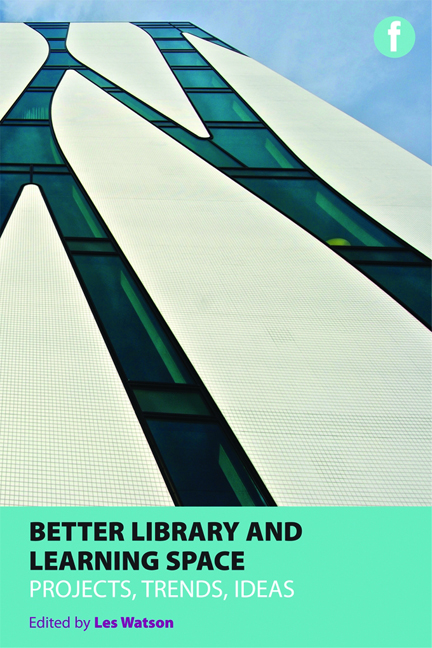Book contents
- Frontmatter
- Contents
- Case studies
- Acknowledgements
- Contributors
- Introduction – about this book
- PART 1 PROJECTS AND TRENDS
- PART 2 TRENDS AND IDEAS
- PART 3 IDEAS AND FUTURES
- Introduction
- 11 Beyond space: access is all – or is it?
- 12 Thinking inside the box
- 13 Nothing has changed/everything has changed – the enduring aspects of learning
- 14 Books, nooks and MOOCs
- 15 The researcher's view: context is critical
- 16 Libraries in the network society: evolution, revolution, extinction?
- 17 Powered by learning: developing models of provision to meet the expectations of new generations of students
- 18 The library has left the building
- 19 Beyond analogue: the learning studio as media-age library
- 20 3D libraries for 3D smarting
- 21 Learning landscapes, the library and the University of Lincoln: efficiency, effectiveness, expression and experimentation
- 22 Viral design: learners building better environments together
- 23 The interior designer's view
- 24 Furniture fit for the future – a brief exploration of library and learning furniture today and for the coming generation
- 25 Conclusions
- Index
24 - Furniture fit for the future – a brief exploration of library and learning furniture today and for the coming generation
from PART 3 - IDEAS AND FUTURES
Published online by Cambridge University Press: 08 June 2018
- Frontmatter
- Contents
- Case studies
- Acknowledgements
- Contributors
- Introduction – about this book
- PART 1 PROJECTS AND TRENDS
- PART 2 TRENDS AND IDEAS
- PART 3 IDEAS AND FUTURES
- Introduction
- 11 Beyond space: access is all – or is it?
- 12 Thinking inside the box
- 13 Nothing has changed/everything has changed – the enduring aspects of learning
- 14 Books, nooks and MOOCs
- 15 The researcher's view: context is critical
- 16 Libraries in the network society: evolution, revolution, extinction?
- 17 Powered by learning: developing models of provision to meet the expectations of new generations of students
- 18 The library has left the building
- 19 Beyond analogue: the learning studio as media-age library
- 20 3D libraries for 3D smarting
- 21 Learning landscapes, the library and the University of Lincoln: efficiency, effectiveness, expression and experimentation
- 22 Viral design: learners building better environments together
- 23 The interior designer's view
- 24 Furniture fit for the future – a brief exploration of library and learning furniture today and for the coming generation
- 25 Conclusions
- Index
Summary
What is furniture for?
In this article I endeavour to investigate the trends driving library and learning spaces forward from a furniture designer's perspective and explore how furniture may evolve to facilitate this journey.
The advance of technology has led us all a merry dance over the last 30 years. In 1983 I rang people on my telephone – it is now 2013 and my smart phone sits on the desk beside me. On last count this clever, potent machine has replaced no fewer than 45 products and services in my life. Irrefutably, technology's rapid rate of change promises to influence the furniture used in library and learning spaces dramatically.
Let us focus on the furniture we currently use and consider where this may lead in the coming generation. To put our investigation in context let us underpin it with three simple ideas:
• Furniture is for people. For the most part people need somewhere to put themselves (typically a seat) and somewhere to put things (shelves) and do things (worktops). Good furniture is about ‘people fit’.
• Change is certain, and great flexibility in library and learning furniture is absolutely key to future-proofing.
• People will always seek social context in community hubs and they will always need to learn. The future of libraries and learning facilities is assured, though their forms will continue to transform.
Staff versus the machine
Recent surveys indicate that for many library users interaction with staff remains an important component of their library visit.1 Apart from offering practical assistance librarians are people helping people and providing important social context – there is no replacement for a welcoming smile. Though libraries will undergo continuing automation staff–user interaction will remain an important part of library life and furniture will continue to be needed to support this.
Front of house minimized
We are in the midst of a general trend to break down the barriers in search of enhanced customer experience. This has been supported by the move to customer self-service models, including issues, returns and reservations, which make the old-style circulation counter (I call them fortresses) increasingly redundant.
- Type
- Chapter
- Information
- Better Library and Learning SpaceProjects, trends and ideas, pp. 259 - 268Publisher: FacetPrint publication year: 2013



